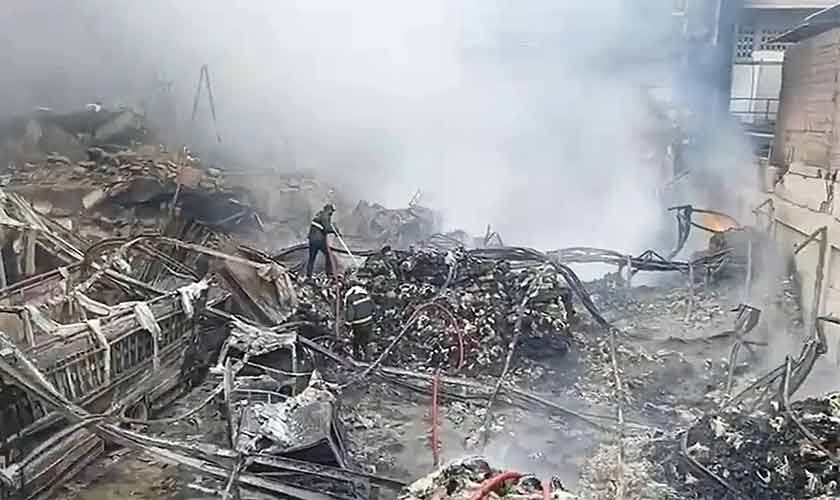In recent days, Karachiites have witnessed several tragic incidents of fire breaking out across multiple locations in the city. The biggest of these erupted on September 9 at a garment factory in New Karachi. The fire blazed for hours, injuring many workers and causing huge financial losses.
Earlier, in late August, at least six people were killed when a fire broke out following an explosion in a warehouse located in a densely populated area near the Taj Medical Complex. The same month, a massive fire erupted in a factory in the Karachi Export Processing Zone near Landhi, injuring eight people and spreading to at least three other factories.
These tragedies have once again raised the urgent question: why is there no comprehensive and coordinated strategy to deal with fires in Karachi?
### Causes of Hazardous Fires
Electrical and plumbing defects in commercial and residential buildings often go uncorrected. Instead of investing in safety measures, owners and management force employees to continue working despite leakages, sparks in electrical wires, and broken pipelines. Shockingly, some buildings do not even have legal electricity connections.
Overloading and poor wiring significantly increase the chances of short circuits. Additionally, serious flaws in the design and construction of some buildings contribute to fire risks. Issues such as lack of emergency evacuation routes, poor ventilation, and the presence of flammable materials in unsafe locations lead to loss of human lives.
Garment factories, sewing workshops, warehouses, and oil depots situated in crowded inner-city areas are particularly vulnerable to such hazards.
### Safety Systems and Legal Enforcement
Experts estimate that about 70 percent of residential, commercial, and industrial buildings in Karachi lack adequate fire safety systems. There is a severe shortage of essential equipment including fire alarms, fire exits, and sprinklers. Residents have not been given emergency training, and public awareness campaigns are virtually non-existent.
Although building bylaws mandate the presence of fire-fighting infrastructure such as standpipes, water tanks, alarm systems, and fire-prevention walls, their implementation remains negligible.
Fires frequently break out in buildings across Pakistan due to poor infrastructure, weak enforcement of safety regulations, and widespread negligence. According to the Fire Protection Association, about 3,000 fire incidents were reported in Karachi in 2024 alone. The association also highlighted that the Fire Department is under-resourced and lacks an effective strategy to cope with emergencies.
### Challenges in Urban Governance
A critical question arises: why are government agencies unable to take robust measures to reduce fire risks in residential and commercial areas?
The answer lies partly in corruption, political and administrative pressures against uniform law enforcement, lack of resources, and limited capacity of firefighting agencies. The number and facilities of fire brigades are grossly inadequate relative to Karachi’s vast size and population.
The situation is worsened by delayed arrival of firemen and their inadequate access to water and necessary equipment, which hampers timely and effective fire response.
### Increasing Fire Risks Due to Unplanned Development
Experts attribute the rising number of fires in warehouses, markets, and stores in Karachi chiefly to unplanned development and severe lack of safety measures. Most warehouses and commercial centers have been constructed without formal plans, lacking basic fire extinguishing water systems, fire hydrants, alarms, or ventilation.
The use of poor and highly flammable construction materials allows fires to spread rapidly. Many warehouses in the city’s crowded and old commercial centers, such as Empress Market, Bolton Market, and New Karachi, are located in narrow streets inaccessible to fire brigade vehicles. This leads to response delays, allowing fires to erupt into disasters.
Faulty and old wiring, as well as proximity to high-tension electricity lines, are common causes of fire due to overloading and short circuits. Furthermore, these centers store large amounts of clothes, plastics, chemicals, oil, and other flammable materials without separate zoning or safety protocols, turning even a small spark into a major explosion or fire hazard.
Most warehouses and markets also lack emergency exits and safe escape routes, making rescue efforts significantly more difficult.
### Weak Supervision and Lack of Coordination
A major reason for this dire situation is weak supervision by city administration. There is ineffective coordination among the Building Control Authority, the Department of Industries and Commerce, and the Fire Brigade.
Safety audits of buildings are rarely conducted, although they should be routine. Moreover, deterrence through strict fines and punishments for violations is practically non-existent, prompting many building owners to overlook essential security measures to cut costs.
### Preventive Measures and the Way Forward
The government must prioritize fire safety as a top agenda item. The first step is collecting accurate data. The statistics department and local government should collaborate to conduct regular surveys and safety audits of factories, warehouses, and residential buildings, especially in older and densely populated areas, to identify defective structures.
Installing fire alarms and sprinkler systems should become mandatory. Building codes must require safety exits during construction and renovation phases.
Institutional and community engagement is equally vital. Trade associations, civil society, labor unions, and the media must actively participate in raising awareness and promoting action.
Investing in fire brigades and enhancing their capacity is crucial. Procuring modern fire tenders, equipping personnel with the latest tools, and comprehensive training will enable effective handling of large-scale incidents.
Public awareness is also key to prevention. Fire safety training should be incorporated into schools, colleges, and workplace workshops.
### Conclusion
Recent fires in Karachi have exposed the critical need for a comprehensive fire safety policy, strict legislation, and effective enforcement. Without timely and coordinated measures, such devastating incidents are likely to increase, putting lives, livelihoods, and property at continuous risk.
It is imperative that all stakeholders—government, businesses, and the public—join forces to make Karachi a safer city for everyone.
https://www.thenews.com.pk/tns/detail/1345122-playing-with-fire



